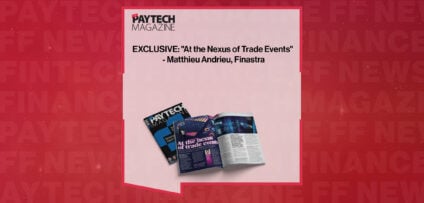Breaking News

EXCLUSIVE: “Right on the Money” – Baran Ozkan, Flagright in ‘The Fintech Magazine’
Reliable automated compliance is a Holy Grail for small fintechs. But what that usually means is huge staff resource or expensive systems the organisation can’t afford. The founders of Flagright felt their pain… and came up with a solution
When Baran Ozkan built his AML compliance software, he knew exactly what he didn’t want. Responsible for compliance and fraud prevention in a previous job with a new fintech in Lithuania, Ozkan spent 15 months hunting for a real-time solution for the business. But despite big promises from salespeople, the software he encountered was either too expensive or functionally weak, with poor tools, baffling user interfaces and immature APIs.
Ozkan concluded the existing providers had no interest in the needs of a startup. He’d identified an opportunity and Flagright was born. Together with co-founder Madhu G Nadig, he developed an ‘AI-native’ AML compliance solution run via a no-code console, which has developed into the AI Forensics product we see today. By giving AI more control of monitoring processes than its rivals, the tool delivers reports in seconds, not hours, days or even weeks, says Ozkan.
And more than that, it has been designed to ‘delight’ the back-office compliance staff who will work with it, week in, week out.
“No one cares about back-office staff. Imagine it, 9am to 6pm each day, clicking buttons,” he says. “Our plan was to make an impact on those lives, while delivering great value to their organisations by cutting the massive cost of AML compliance. We wanted to provide AML staff with a pleasant journey. There’s a Walt Disney quote that people can ‘feel perfection’. The best feedback we’ve received is people telling us it’s by far the most intuitive platform they’ve seen.”
An ‘AI-native’ solution
The Flagright story took off when Ozkan and Nadig won a place in a 2022 round of the Y Combinator startup programme, which provided them with both funding and expert advice. From there, the company’s offer for smaller businesses and startups was honed – an all-in-one solution to manage financial crime risk and meet AML compliance with a usage-based pricing scheme that meant fintechs could afford banking-level AML compliance protection.
Flagright’s platform has proprietary features for transaction monitoring, case management, risk scoring and AML screening, as well as others provided by partners via an API, such as sanctions screening, ID verification and blockchain analytics. Due to the modular design, components integrate with each other to provide the ‘all-in-one’ solution that Ozkan anticipated future customers would demand.
The key point of difference – the ‘AI native’ aspect – means a machine does more of the work and humans are upskilled to provide an oversight function, rather than working alongside it, as is more commonly the case currently.
For AML, that means AI drills deep to detect suspicious activity such as behaviour changes, and every individual or organisation being monitored has their own alert parameters. Low-risk users have a higher anomaly threshold than higher-risk users – and overall, Flagright claims a 93 per cent reduction in false positives, thereby slashing staff workload. Another example of the system’s automation is a ChatGPT-powered system that monitors a fintech’s merchants across public sources and social media channels to identify changes that could indicate wrongdoing.
“Compliance is one of the biggest costs for a financial institution, and LLMs are almost a tailor-made tool to bring that cost down”
On the front end, the AI Forensics platform is code-free, so staff simply enter their instructions and queries in their own spoken language. And its AI Narrative Writer fulfils communication tasks for workers, such as report writing, and captures their particular writing style – further slashing task time and therefore cost. Another efficiency Flagright can boast is the speed at which its platform can be installed by a customer – typically between one and two weeks, which compares to an industry benchmark of two to four months.
Ozkan says: “With our AI Forensics product, it’s essentially a set of AI agents that are tailor-made to handle very specific things. Banks may have machine learning detection but a human investigates and they still spend 30 minutes per alert – and there could be millions of alerts per month. When we say AI native, we want most of these operations done by AI, and LLMs [large language models] are very powerful in terms of helping with that end vision.
Compliance is one of the biggest costs for a financial institution, and LLMs are almost a tailor-made tool to bring that cost down because there’s just so much automation potential you can enable.”
How it works
When AI Forensics triggers an alert, it allows users to manually drill down into its data or use an autopilot feature that collates relevant information to present an investigation. That investigation typically pulls up the individual’s details, their history of alerts, historical transaction risk scores, transaction data, any suspicious activity reports filed on the individual, and creates pivot tables to identify who the individual has transacted with.
On identification of these third parties, it automatically scrapes their websites to reveal what they say about themselves, and checks for deviations such as a business industry change. Once collated, AI Forensics suggests further steps that should be taken – and can then write a report. Ozkan says: “The tool doesn’t just look intuitive, it is intuitive.
“When you click, all of those journeys are very thought through. Tasks can be achieved easily and quickly. For example, for the majority of our competitors, they will take one to two weeks to generate a report. For us it takes 30 seconds. The underlying infrastructure and computing power is drastically different. Obviously, our aim is to isolate that complexity for customers so they are not confused by it – we render data in a way that makes it easy to understand.”
Funding success
From Flagright’s inception in 2022, the business moved fast. In April 2023, it opened an office in the US and the following month a sales operation was launched in Singapore. More recently, the business opened an EMEA headquarters in London, and its New York operation is currently being expanded.
But despite already having customers across six continents, Ozkan says work is needed to boost Flagright’s brand awareness – and some of the money provided by a $4.3million funding round in January 2025 will be used to do that. The investment, led by Frontline Ventures with participation from Y Combinator, Pioneer Fund, Moonfire Ventures and others, followed a $2.8million seed fundraising round in July 2022.
Ozkan says: “Y Combinator was our biggest milestone. We developed the business idea and met a great network, which provided us with support. From then, we’ve worked to earn the trust of our audience globally. To do that, we’ve targeted security certifications such as ISO and SOC 2, and we’ve doubled down on the future, which is generative AI-led tooling.
“Paul Graham, a co-founder of Y Combinator has a phrase I like, he says ‘in order to receive an investment, just be investable’. We’ve tripled revenue year on year – I guess the reason we’ve received the latest funding is because we are a very good business.”
Ozkan argues the days of batch processing and delayed risk assessments are fast coming to an end and real-time compliance features will become the norm. While AI is already reducing false positives, over the coming decade he believes the technology will fully automate risk assessments, flagging only the highest-risk cases for review by a human.
And that’s important on so many levels.
The Nasdaq global fraud report for 2023 estimated $3.1trillion of illicit funds flow through the financial system that year, with an estimated $347billion linked to human trafficking and $783billion to drug trafficking.
Two years ago, Flagright agreed a partnership with the US-based Anti-Human Trafficking Intelligence Initiative, ATII, which involves data sharing between the two organisations. It was a sign of Flagright’s stature and global intent.
Ozkan says: “We will use the latest funds to double down on our broader market and in our core markets, which are North America, Europe, the UK and the Asia-Pacific region. We are building teams in all the regions because we’re so new that people still haven’t heard about us. We will invest in brand awareness so people know what the most important tool in the market is.
This article was published in The Fintech Magazine Issue 34, Page 12-13
People In This Post
Companies In This Post
- SAP Fioneer: From Core Strength to Behavioral Banking Read more
- Trulioo Powers Record-Breaking U.S. Growth as Global Enterprises Seek Unified Verification Read more
- Small Businesses Are Struggling and SaaS Platforms Are Eyeing Banking Revenue as a Result Read more
- How DataHaven Is Delivering Measurable Impact For Carriers Read more
- EXCLUSIVE: “At the Nexus of Trade Events” – Matthieu Andrieu, Finastra in ‘The Paytech Magazine’ Read more


















